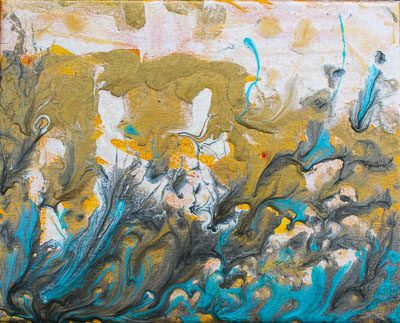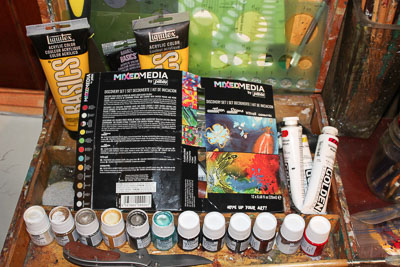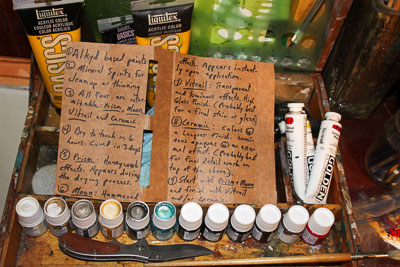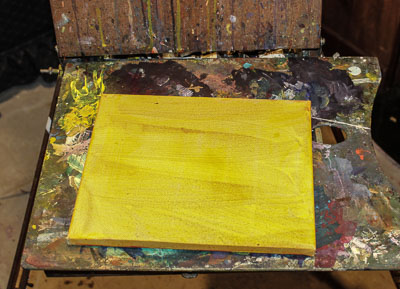|
A Critique of Alkyd Paints:
Part One

Permission is granted to reprint the following article as long
as no changes are made and the byline, copyright information,
and the resource box is included. Please let me know if you
use this article by sending an email to dje@newedisongazette.com.
A Critique of Alkyd Paints: Part One
Copyright © April 3, 2016 Douglas W Jerving.
All Rights Reserved.
A few months ago I received a very large discount coupon from Michaels Arts and Crafts. Previously, I had been looking at some of the amazing tiny canvas-board artworks that were used as promotionals for the Pebio Mixed Media alkyd paints. They looked like something my wife, who does a lot of craft-oriented painting, might like. On a whim I bought a very small $12 set of the paints which she proceeded to never use. Still, I was interested, and since I now had that huge discount, and only a few days before it expired, I purchased the next larger set for my own experimentation. I got a nearly $40 set of twelve paints for just a bit more than that $12 starter kit. Such a deal, such a deal!

One month later. Tonight I was slightly bored and needed to change the routine. I saw the carton of those paints sitting next to my art table the other day, and so tonight I pulled them out. After extracting the twelve little bottles of pigment I cut up the cardboard container to save the sole source of information found on it in a flat, easy-to-file format. I studied it and took notes on the inside of the carton. Pebio is a French company. All the documentation on the carton is in English, French and Spanish. I needed my magnifying glass to read it.

Pebio Mixed Media paints are alkyd based pigments. Alkyds are made from alcohol and fatty acids. (“Al”=alcohol; “kyd”= acid). While acrylics are water soluble plastics, alkyds are a mineral spirit solved polyester. (Years ago my wife and I jokingly considered naming a daughter Polly Esther. I guess that would have been better than Polly Ethel Lena. I’m sure my four daughters are all glad we had more sense.)
I have painted exclusively in oils for forty-some years. For the past two years I have been slowly moving to acrylics as my main media. The change has been for aesthetic, not health, reasons. If health had been an issue, as it is for many artists, I would have moved long ago. Many artists move from oils to acrylics because of their sensitivity to the chemicals associated with oil paints. I have never been bothered by oils, maybe because up until the last ten years, I have always been a plein-air artist, working mostly outdoors, and then finishing my work with minimal time in the studio. Now that I am older, studio work is more dominant. Health issues related to the medium used become a real possibility in the closed environment of a studio. They have never been an issue, thankfully, for me.
So tonight I found a small (8” x 10”) canvas that I had already grounded with an orangy acrylic color; my typical foundation for every painting. I laid it flat horizontally on my easel rather than my customary vertical so as to prevent runs since the Pebio paints are very fluid. I am not sure if there are other alkyd products available that have a higher, more impasto viscosity. The intended effects of the medium imply the necessity of a lower viscosity than oil or acrylic, and therefore, also, a horizontal painting surface. Because the canvas is necessarily horizontal, the artist is forced to work closer to the surface of the work, and is more directly influenced by the vapors.

After half an hour dabbling, I considered this small piece done. Just a quick abstract landscape. I could set it aside and come back later to add highlights and details. Already I was very impressed with the quality of the media for creating powerful work. I will go into further detail on the process in part two.
As I mentioned before, I have used oils all my life, and the volatile chemicals have never bothered me, even in the closed environment of the studio, and even when working for hours at a time. I can’t say that for alkyds. After a half hour of work my basement studio was overwhelmed with fumes that would have killed off cockroaches if we had them. I could have lit a cigar and blown up the house. I took the painting out to my garage to dry. (Drying to touch requires six hours; full curing takes three days.)
The fumes were still pretty terrible after removing the offender. They lofted up to the first floor, so we had to open the back door for an hour just for some fresh air. We provide food and clean water for the stray cats in our neighborhood. This on a night when the water in the cat bowl glazed with ice! Two hours later the harbinger scent of chemicals still hanged over my art table.
Do not use alkyds unless you are in a very well ventilated area. They are advertised as valuable additions to your studio work without any warning that I found regarding their health hazards beyond a microscopic “CAUTION: CONTAINS PRODUCTS THAT MAY BE HARMFUL. READ WARNINGS ON EACH CONTAINER.” referring to jars that are less than two inches tall. Three hours later, I still smell this stuff.
Wonderful as these paints are for their effects, I recommend that you use them outside of your house or studio. They may be a great way to get out and enjoy a nice sunny day.
In part two I will discuss the various paints themselves, and their effects.
------------------------
Doug Jerving is the publisher of the NewEdisonGazette.com. You may contact him at
dje@newedisongazette.com.
=================================

Return to The New Edison Gazette main site.
|
|